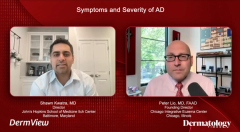
Important Topical Therapy Considerations for AD
Shawn Kwatra, MD, offers important considerations for providers when utilizing topical therapies for atopic dermatitis (AD).
Episodes in this series

Transcript
Shawn Kwatra, MD: The 1 thing I try to be very cautious of, and I know you’re probably very thoughtful about this yourself, is the potency of the topical steroids. You alluded to the topical steroid withdrawal and other things like that. I personally have now seen many patients who come in and they’ve been given a topical steroid outside. They come with some things that are almost irreversible, striae, or just pigmentation. It’s a little heartbreaking because sometimes folks say that they weren’t given that conversation about how you have to use it intermittently and it may be only for a few weeks at a time. That’s one of the reasons that I think we’re a little bit more careful, especially on the eyelids, before we had these nonsteroidal agents. I got so scared about giving a topical steroid, even hydrocortisone for a long period of time, because I worried about those little twinge occasions in the genital region. If it’s on the trunk, or the body, I’m always thinking of topical steroids, like you.
We’ve had a big shift since we had the first PDE [phosphodiesterase] inhibitor approved and now, we have another one, topical roflumilast, that’s in development and has some great phase 3 data, a really elegant formulation as well in addition to other topicals like tapinarof in development, but with the topical JAK [Janus kinase inhibitor], I totally agree. It’s like a topical triamcinolone with middle-potency steroid, or stronger, which is pretty unprecedented in our therapeutics landscape. That’s where I start the conversation and then I talk to folks about where there are most stubborn areas. I try to prioritize the areas that may be at the most risk for atrophy with a topical JAK inhibitor. Oftentimes, I’m also giving multiple things together depending on how much body surface area is involved. That’s an important consideration. Another thing that I found really helpful is, when I’m evaluating folks and thinking about topical agents, I actually take my eyes off of the equation for a second. I ask folks, “Hey, tell me, how would you rate your edge on a scale of 0 to 10, where 10 is the worst issue that you had in the last 24 hours?" Most times, folks don’t want to answer, but I’m persistent and they have to give me a number. I do this on every visit and 1 thing I've noticed is that there’s oftentimes a big mismatch in that number and what I’m seeing.
One thing we know is that there is inflammation that is not perceptible with our eyes. Dr Emma Guzman’s lab and other labs have done biopsies of lesional and nonlesional skin, where we’re finding even in nonlesional skin that there seems to be more inflammation in these patients. The itch is not limited to only the areas that look like the most examined sites, and in our lab, we have been doing studies on the blood even in folks with more limited disease, showing that there’s more inflammation. Things like that had been very helpful for me to decide on the right therapy and ask about it objectively. The other group that this is very helpful for is skin-of-color patients, and I’m talking about particularly Black patients, because…[it] is very difficult to detect erythema. It’s very hard; sometimes it looks purplish and sometimes it just doesn’t resonate as much. Many of these tools like the EASI (Eczema Area and Severity Index] score underestimate the erythema, but their scores may be lower. We have less diversity of patients in a lot of these clinical trials, too. I try not to underscore their disease. I’m very thoughtful about going about it and asking about the itch. If someone’s having an intense itch, that, to me, is a signal of inflammation. When I hear an itch score, say, above a 5 or 7, the first thing I think about is that I see those cytokines. I’m seeing IL[interleukin]-31, IL-13, IL-4, and I’m seeing those nerves, and the interactions I’m trying to break. That is kind of a bench-to-bedside approach where when I hear about it, I jump into action. Particularly, it doesn’t matter if it’s very exam enticed or not. I do something where if folks are very itchy, I could give them a topical JAK inhibitor, or topical ruxolitinib. They could do a daily, or topical steroid, for a few weeks at a time, or whatever the patient would like. Even when they get better, sometimes I’m concerned that if I just stop cold turkey, that that itch may come back, or that inflammation may come back. Sometimes, I’m treating people, getting them better, and I’m also saying, “Hey, let’s not stop there.” Sometimes I do like twice a week of a topical calcineurin inhibitor, or twice a week have a topical JAK inhibitor to try to keep it away, especially because of the chronicity.
Peter Lio, MD, FAAD: Definitely. I love it. There’s a lot to unpack because the first thing you said that really struck me was just the idea of the disconnect between the way something looks and the way the patient feels. I feel that this kind of rhymes with what we started the whole conversation with…the idea of dismissing it. People are so quick to dismiss atopic dermatitis. “Oh, it’s just eczema. It’s a skin thing. I handle hypertension.” Yes, but the impact on this is actually way worse. Hypertension is a serious condition, but this is worse when you look at the quality of life. That’s part 1. Part 2 is that the invisible piece gets lost. Then, for part 3, I love that you brought up more richly pigmented skin. I always tell the story. I had a patient with very dark pigmentation. She was maybe 7 years old, and we were in the exam room for a while. She had been listless on the bed. I said to the mom, “What’s going on?” The mom’s like, “She’s been kind of like this these the last two days and it’s sort of like ‘snap to attention!’” We’ve been talking for a few minutes, but it just sort of struck me as being odd and from afar I didn’t appreciate that she was that bad and she was a risk for dermic. If it’s somebody with lighter pigment, you’d be able to see that and it’d be bright red, but because she had so much melanin, you just didn’t appreciate that. Once I put my hands on her, I said, “Oh my goodness, she’s feverish.” She had sepsis. I physically carried her down to the emergency room. It was like, oh, my God, I’ll never forget that moment of saying I didn’t see it. I walked into the room and I hadn’t done a formal exam yet, but I didn’t even think that because of that. It’s obvious that that was a pretty extreme case, but I think you’re right, you can sort of undercoat it and say well, it doesn’t look that red. We have to ask these bigger questions and have to probe more. Then, we must think about yes, this is a therapeutic landscape and I love what you’re talking about, but sometimes you don’t want to just stop because for the mildest disease, maybe you’re just reactive and you say, “When you’re flaring up and when you feel itchy, it turns red, so put this on when you’re better.” If you’re mild enough, that’s great. You don’t need us, but I always say that there are 3 great hurdles. The first hurdle is can I get you clear in the first place? Usually, we get some clear. The second hurdle is really hard. Can I keep you clear safely? That’s where I start doing things like you, proactive therapy; that’s also where I use my nonsteroidals a lot. I might say: “Use your steroid, triamcinolone, mometasone, or fluocinonide, for a few days, maybe a week, and get better. When you’re better, I don’t want you to go cold turkey because we’ve been down this road before, and you flare right back up. Instead, I want you to now switch to crisaborole, or maybe it’s going to be ruxolitinib.” It’s something where it’s nonsteroidal, maybe it’s not even every day, but when we need it, of course, we know that we can’t use it continuously. We can’t use it for more than 20% of the body surface area. Again, sometimes we’re mixing and matching. And then that third hurdle just to finish the thought is, can you keep it up? That’s the other piece. Sometimes patients are like, “Well, I’m pretty good and I’m staying pretty clear, but I’m exhausted or I can’t afford it, or I’m going to be traveling now and I can’t bring all of these screens.” We have to let you know that it’s a dynamic thing. It’s a moving target, so we have to keep reevaluating at each visit, and we have to keep in touch. That’s the hardest thing for all of us. We’re all busy, and we’re blessed that we’re busy. We have a huge waiting list, right? Patients want to get in, but to do optimal care for these patients, every visit is kind of a new visit. Where have we been? What are we up to? Where are we going? You know, you have to keep reassessing. Otherwise, you’re a broken record. That’s how we get to what you described, people who continuously use steroids in sensitive areas and are getting damaged from it.
Transcript edited for clarity.
Newsletter
Like what you’re reading? Subscribe to Dermatology Times for weekly updates on therapies, innovations, and real-world practice tips.


























